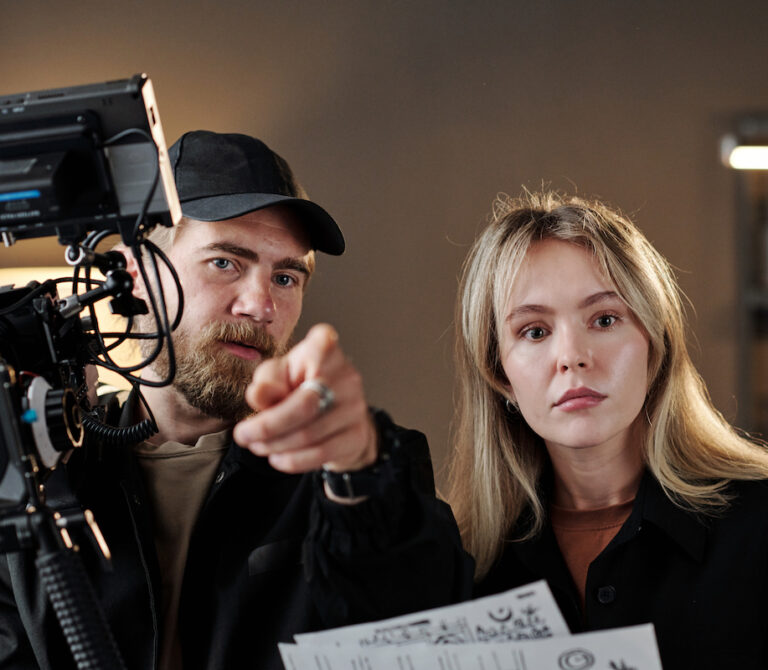And as we forge our way into 2022, let’s touch on a topic that Voice123’s Customer Success team deals with on a daily basis: the best way to communicate with the voice actor you’d like to hire for your voice over project. Let’s start off with the assumption you’re new at this, but don’t necessarily want to appear that way. As with any specialized creative environment, voice acting has a lingo associated with it. Oh — you didn’t know there was one? Well, yup: there is and being able to understand it as well as speak it is crucial. It’s all about the drama of the moment, no matter how long that moment might be.
You see, voice actors are unique people. Seriously. They often need to produce anything from a whisper to a scream, strange sounds, animal noises, sound effects and, of course, accents from around the world. They’re often introverted and have to spend their lives acting extroverted.
It makes you wonder, what goes on inside their heads? 😀
Voice acting is as mysterious as it is creative. The source of voice acting goes beyond the voice, it lies within creativity itself!
After all, there’s no switch in the larynx (the voice box) that you can turn on, and suddenly you’re qualified to be a voice actor. Instead, a lot of voice acting comes from a person’s fundamental talent for mimicry, as well as their thoughts and imagination — things without limits and often without real definition.
And so it begs the question, if it’s so loosey-goosey, how do voice actors make sense of the art and craft of voice acting? How do you, as a client, communicate with them on a level so they understand what it is that you want?
The language

The good news is, voice acting isn’t entirely abstract like… abstract art. Luckily, we can speak in a way that is meaningful to a voice actor.
It helps to understand some of the language that voice actors use during the creative process. A great way to start is by learning some voice acting terms.
This way, when someone refers to the ‘bed’, you’ll know it’s the instrumental track underneath the voice, and not that the voice actor needs to rest.
More frequently-used terms might include cadence: how breaks are placed between words; or copy-points: unique features of a product or service that should be emphasized in an ad read.
Getting familiar with voice acting terms not only helps you direct a voice actor, it also builds a common language. Consistent use of a common language will smoothen your workflow, and help you start producing better and faster results.
Get technical
We can also look at terms like timbre, inflection, and tempo, just to name a few. These can help direct a voice actor and pinpoint what’s desired in a script read.
Timbre is the quality of the voice — is it raspy, or clear? Inflection is the way the pitch (whether the voice sounds high or low) changes during the pronunciation of a word. And tempo is the speed at which the script is read.
Using technical language is better than using subjective language. Using general words like happy or sad can create many interpretations!

Given circumstances
Once you’ve briefed yourself on voice-acting lingo, it’s important to know what goes on inside a voice actor’s head.
Yes, there is more than bells, whistles, and the constant repetition of that one line they’re trying to memorize. You’re more likely to find that a good actor’s head is full of given circumstances, noted in the Stanislavski Method, a popular method of acting.
Given circumstances are what set the scene for the actor to act in. Think — who, what, when, where, and why?
Voice actors can spend hours studying given circumstances by diving into source materials, storyboards, character backstories, pictures and descriptions, lore, and more. It helps them create a character and bring a script to life.
Goals and objectives
Speaking of creating a character, it’s worth knowing the system of objectives from the Stanislavski Method.
Objectives in voice-acting are equivalent to a character’s goals.
“Character,” you ask? Consider this: even a plain script-read of an ad has a character behind the voice.

It can be simple. The goal of the character in, let’s say a commercial read for laundry detergent, is to tell the audience how spotlessly-clean the detergent will make the clothes. The next objective is to tell the audience how the scent of the detergent will be like a cool, summer breeze.
There’s also the super-objective, which is something like an overarching objective. Such as sharing everything the character likes about the detergent.
Voice actors use objectives to build a realistic character as they move from moment to moment in a script. It’s how we speak from day to day, we discover what we want to say as we say it.
Intention
Intention is the mental equivalent of “putting your back into it.” It’s very general and not necessarily something you can act on.
It’s the aim or plan, and not an action or objective. Different intentions will change how a voice actor reads a script, and it’s worth thinking about in order to communicate with a voice actor.
Final thoughts
It’s a lot to go through, but learning the language of voice acting is going to give a lot of value when you’re working with the wonderful roster of talented, professional voice actors we have at Voice123.

To summarize, it’s all focused on building a character for the voice actor. Everything is just meant to support that. Even if you don’t use all the lingo, if you have the same focus, you’ll be on the right path to using the language of voice acting!



































































